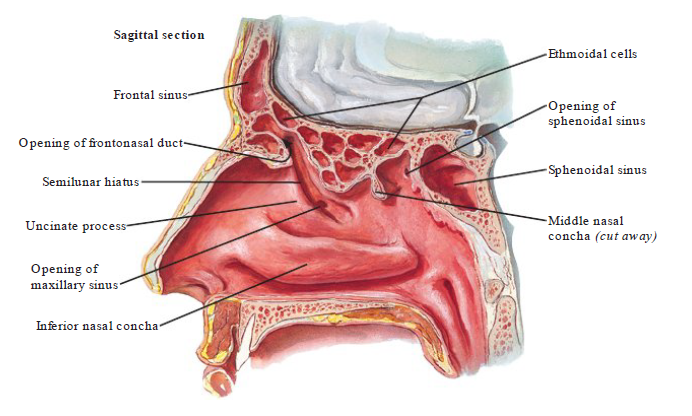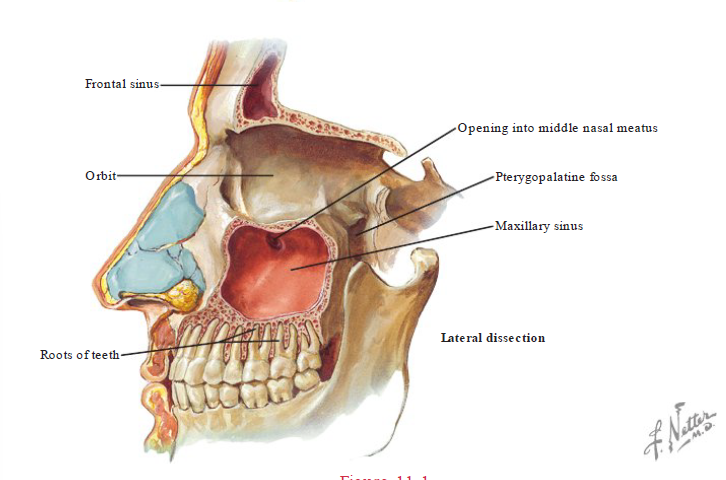Gen Ana: Nose, Nasal Cavity, Paranasal sinuses
1/103
There's no tags or description
Looks like no tags are added yet.
Name | Mastery | Learn | Test | Matching | Spaced |
|---|
No study sessions yet.
104 Terms
Nose
prominent anatomic structure
Inferior and medial to the eyes
Location of the nose
helps in breathing and olfaction
Function of the nose
pseudostratified columnar epithelium with cilia
Highly vascular and easily congested
Respiratory epithelium of the nose
Its blood vessels reflexively dilate and the glands secrete, normally leading to sneezing.
What happened when the tissue of irritated nose occur
Sagittal section

Lateral dissection

pyramidal in form
the nose is a ___________
because these are the most frequently broken bones in the face.
Fractures of the nasal bones are common —
piriform aperture
the opening in the skull is _________
Nasal
Maxilla
piriform aperture is bounded by 2 bones
frontal (nasal process)
maxilla (frontal process)
nasal
3 pairs of bones form the root of the nose
Because the root of the nose is made of bone.
why the anatomy of the nose is fixed
septal
lateral nasal (upper nasal)
Major alar (lower nasal)
3 different major cartilages form the dorsum and the apex of the nose
lesser alar (3 to 4 cartilages)
vomeronasal
minor cartilages that complete the nose are the
because the dorsum and the apex are cartilaginous
why the nose is quite mobile
vestibule
the cavity of the nose opposite the alar cartilage
vibrissae
is lined by many coarse hairs
keratinized stratified squamous epithelium
what epithelium cover the skin over the nose
atrium
the cavity of the nose to the vestibule
2 nostrils or anterior nares
What can be found at the apex are found the ______, which are separated by septum connecting the apex to the philtrum of the upper lip
Because it helps connect the cartilages together and posteriorly to the maxilla
why fibrous tissue in the nose is important
submandibular lymph nodes
the primary lymphatic drainage of the nose is into the
ophthalmic artery
maxillary artery
facial artery
the blood supply to the nose arises from the 3 major arteries
these vessels are derived from the external and internal carotid arteries
these arteries anastomose along the nose
many nosebleeds are due to trauma to the septal branch of the superior labial artery from the facial artery
ophthalmic artery
maxillary artery
facial artery
its due to trauma to the septal branch of the superior labial artery from the facial artery
Why they are many nosebleeds occur
Ophthalmic artery
enters the orbit through the optic foramen immediately inferior and lateral to the optic nerve
crosses the optic nerve to reach the medial part of the orbit
while in the orbit, besides other branches including the orbital vessels, it gives 2 major branches that supply the nose:
Dorsal nasal
External nasal from the anterior ethmoidal artery
internal carotid artery
where does ophthalmic artery innervates
Dorsal nasal artery
1 of 2 terminal branches of the ophthalmic artery
exits the orbit along the superomedial border along with the infratrochlear nerve
supplies the area along the bridge of the nose
ophthalmic artery
dorsal nasal artery innervates
external nasal artery
a terminal branch of the anterior ethmoid artery
supplies the area along the external nose at the junction between the nasal bone and the lateral nasal cartilage
anterior ethmoid artery
external nasal artery innervates
maxillary artery
Gives rise to a series of branches; only 1 provides blood
supply to the nose: nasal branch of the infraorbital a.
Nasal branch of the infraorbital artery
what is the only one branch that provides blood that supply to the nose
external carotid artery
maxillary a. innervates
nasal branch of the infraorbital a.
Infraorbital is the continuation of the maxillary a.
Arises with the inferior palpebral branch and the superior labial branch
Supplies the lateral aspect of the nose
Facial Artery
Passes superiorly immediately deep to the posterior belly
of the digastric m. and the stylohyoid m.
Passes along the submandibular gland, giving rise to the
submental a., which helps supply the gland
Passes superiorly over the body of the mandible at the
masseter, giving rise to the:
• Premasseteric a.
Continues anterosuperiorly across the cheek to the angle
of the mouth, giving rise to the:
• Superior labial a.
• Inferior labial a.
Passes superiorly along the side of the nose, giving rise
to the:
• Lateral nasal a.
Following the last branch, it continues on the side of the
nose as the angular a. that terminates along the medial
side of the eye
Tortuous
Premasseteric a.
Passes superiorly over the body of the mandible at the masseter, giving rise to the:
Superior labial a.
Inferior labial a.
Continues anterosuperiorly across the cheek to the angle
of the mouth, giving rise to the:
Lateral nasal artery
Passes superiorly along the side of the nose, giving rise
to the:
Tortuous
Following the last branch, it continues on the side of the
nose as the angular a. that terminates along the medial
side of the eye
Nasal (Septum) Artery
supplies the septum
superior labial artery
Nasal (septum innervates
Alar Artery
supplies the ala of the nose
superior labial artery
Alar innervates
Lateral nasal
supplies the ala and dorsal surface of the nose
facial artery
lateral nasal innervates from
Facial Vein
Begins as the angular v.
Passes inferiorly along the side of the nose, receiving the lateral nasal v.
Continues in a posteroinferior path across the angle of the mouth to the
cheek, receiving the superior and inferior labial vv.
While passing toward the mandible, the deep facial v. connects the facial vein to the pterygoid plexus
In the submandibular triangle, the facial v. joins the anterior branch of the
retromandibular to form the common facial v.
Has no valves that can allow blood to backflow
Angular
From the confluence of the supraorbital and supratrochlear vv. along the medial part of the eye
Travels along the lateral side of the nose to become the facial v.
Superior ophthalmic
Receives blood from the roof of the orbit and the scalp
Anastomoses with the angular v.
Travels posteriorly to communicate with the pterygoid plexus
Inferior ophthalmic
Receives blood from the floor of the orbit
Anastomoses with the angular v.
Travels posteriorly with the infraorbital v. that passes through the inferior orbital fissure to communicate with the pterygoid plexus
branches of the ophthalmic
maxillary divisions of the trigeminal nerve
the sensory supply to the nose arises from
Ophthalmic division of the trigeminal
Arises from the trigeminal in the middle cranial fossa
Passes anterior on the lateral wall of the cavernous sinus immediately inferior to the oculomotor and trochlear nn., but superior to the maxillary division of the trigeminal n.
lacrimal
frontal
nasociliary
Immediately prior to entering the orbit, through the superior orbital fissure, the ophthalmic division into 3 major branches
anterior ethmoid nerve
infratrochlear nerve
the nasociliary branch terminates as the
External nasal nerve
Exits between the lateral nasal cartilage and the inferior border of the nasal bone
Supplies the skin of the ala and apex of the nose around the nares
Internal nasal nerve
Supplies the skin on the internal surface of the vestibule as
the:
• Medial internal nasal n.
• Lateral internal nasal n.
anterior ethmoid nerve
what external nasal nerve and internal nasal nerve innervates from
Infratrochlear nerve
Passes anteriorly on the superior border of the medial rectus m.
Passes inferior to the trochlea toward the medial angle of the eye
Supplies the skin of the bridge of the nose
Also supplies the eyelids, the conjunctiva, and all lacrimal structures
nasociliary nerve
Infratrochlear nerve innervates from
Maxillary division of the trigeminal
Travels along the lateral wall of the cavernous sinus
Passes from the middle cranial fossa into the pterygopalatine fossa via the foramen rotundum 4 branches:
• Infraorbital—this is the continuation of the maxillary division
• Posterior superior alveolar
• Zygomatic
• Ganglionic
what are the 4 branches does the maxillary division of the trigeminal have
Infraorbital nerve
Passes through the inferior orbital fissure to enter the orbit
Passes anteriorly through the infraorbital groove and
infraorbital canal and exits onto the face via the infraorbital foramen
• Nasal (supplies the ala of the nose)
• Inferior palpebral (supplies the skin of the lower eyelid)
• Superior labial (supplies the skin of the upper lip)
once the infraorbital nerve exits onto the face, it divides into 3 terminal branches
continuation of maxillary division of the trigeminal nerve
Infraorbital innervates from
Nasal branch of the infraorbital nerve
supplies the ala of the nose
infraorbital nerve
nasal branch of the infraorbital nerve innervates from
pseudostratified columnar epithelium with cilia
Nasal cavity is lined by
Nasal cavity
inferior portion is larger than superior portion
Olfactory epithelium
located at the superior part of the nasal cavity around the cribriform plate
piriform aperture
anterior opening bounded by the nasal bones and maxilla
nasal septum
frequently deviates to 1 side, giving rise to unequal chambers
lateral walls of the nasal cavity
• Composed o large venous plexuses that have the appearance o erectile tissue
• 3 large elevations, known as conchae, protrude rom the lateral wall
• All o the paranasal sinuses and the nasolacrimal duct drain into the lateral walls of the nasal cavity
• The sphenopalatine foramen, located in the posterior portion o the lateral walls,
connects the nasal cavity to the pterygopalatine ossa
choanae (posterior nasal apertures)
these openings connect the nasal cavity to the nasopharynx